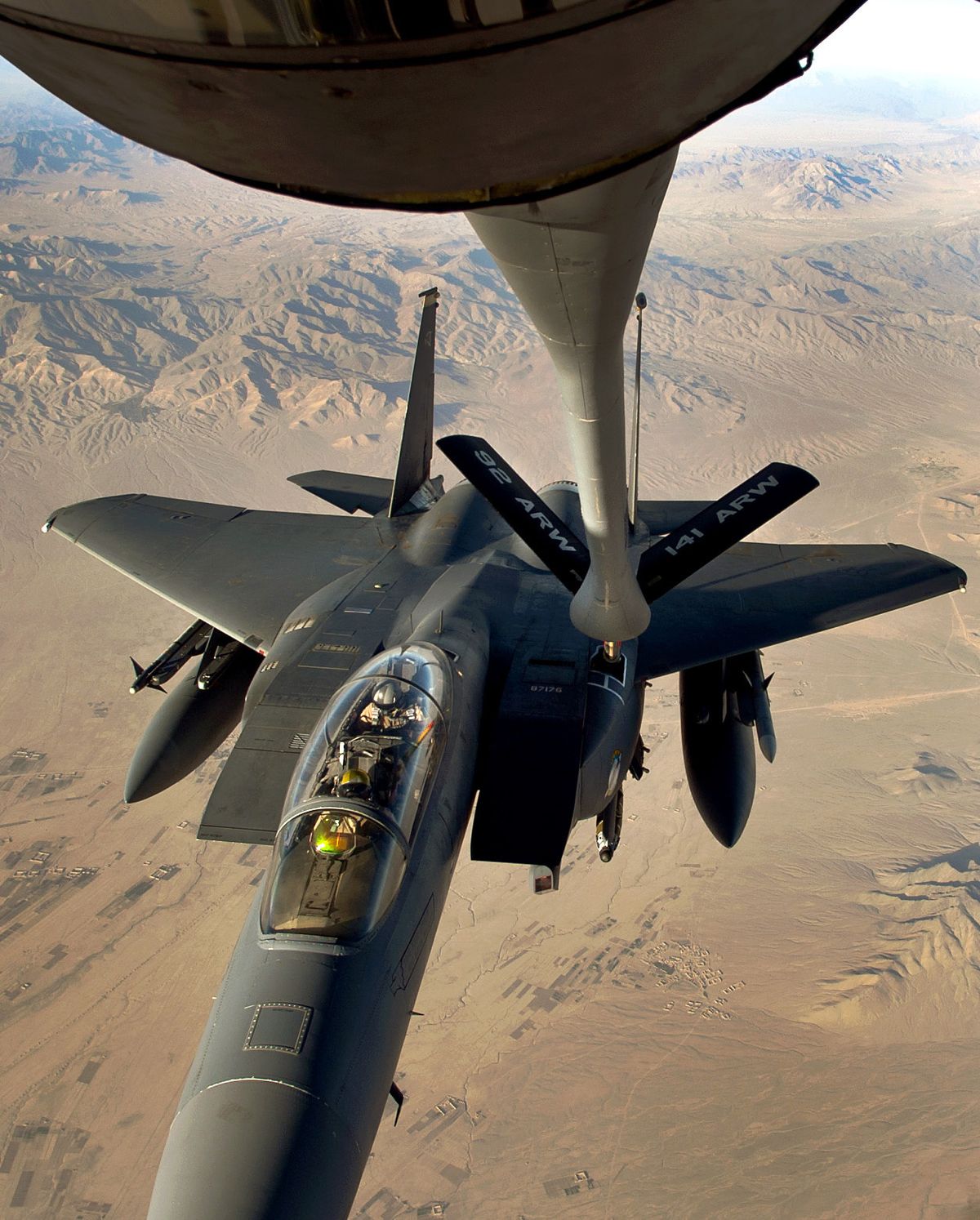Fairchild airmen refuel fighters high above Afghanistan

SOMEWHERE OVER AFGHANISTAN – Staff Sgt. Aaron McLaughlin eased the KC-135’s fuel boom toward the fully armed fighter jet pushing up beneath the tanker’s tail.
Within moments the two aircraft were linked high above the rugged battlefields of Afghanistan as thousands of gallons of aviation fuel pumped into the F-15E Strike Eagle.
“This is what we call a ‘bingo’ mission,” said McLaughlin, a Fairchild-based boom operator with the 92nd Air Refueling Wing in his sixth deployment to Manas Transit Center in Kyrgyzstan. “We’re basically offloading every bit of fuel we can, down to the point where all we’ve got left is what we need to get back.”
The Fairchild-based KC-135R Stratotanker and crew, one of about a dozen of the 92nd Air Refueling Wing’s tankers currently deployed in Kyrgyzstan, refueled six fighter jets Saturday during the six-hour combat sortie. The extra fuel extends the range and versatility of the fighter jets, which provide critical air support for U.S. ground forces battling insurgents.
It’s a delicate maneuver performed numerous times a day over Afghanistan.
“There’s always going to be fuel in the air,” said Lt. Col. Henry “Brad” Hamby, a Fairchild-based Air Force officer serving as commander of the 22nd Expeditionary Air Refueling Squadron at Manas.
Each tanker can carry about 30,000 gallons of fuel, and multiple KC-135s from Manas are in the air around the clock. Needs can change rapidly depending on what combat forces encounter on the ground, Hamby said.
“Afghanistan is a very dynamic environment to operate in,” he added. “It’s common for orders to change.”
During the Saturday mission, for example, the takeoff was expedited to accommodate new orders to rendezvous with one of the Air Force’s elite B-1 bombers. But in flight, the original orders were restored and the KC-135’s pilot, Maj. Sheroyd Brown, took position over Afghanistan to wait for three two-jet teams of fighters: a pair of F-15E Strike Eagles from Bagram air base north of Kabul, two carrier-based Navy F/A-18 Super Hornets, and two more F/A-18s flown by Marines.
Tanker crews call it “the box,” and it’s common to get unscheduled fuel requests from fighter pilots trying to remain aloft over hot spots a bit longer after hearing radio chatter about a tanker in the area. If the tanker pilot feels there’s some fuel to spare, “we’ll give them what we can,” McLaughlin said.
Col. Dwight Sones, commander of the 376th Air Expeditionary Wing at Manas, said the tanker crews are saving American lives on the ground each day.
“We may not drop the bomb or shoot the bullet that kills the bad guy, but you can trace the string back” to the work done at Manas getting equipment to the forces that need it and fuel to the combat jets providing air cover, said Sones, who was stationed at Fairchild from 2001 to 2003 as a KC-135 pilot.
Although considered combat sorties, and a critical part of supporting the ground fight, refueling missions carry significantly less risk than other war zone sorties.
They are, however, still physically and emotionally draining for the pilots and crew.
Keeping high-powered jets safely linked at 20,000 feet, and in varying weather conditions, takes steady hands and a calm demeanor to accommodate for the displacement caused when receiving aircraft ease up beneath the tanker’s tail. Boom operators can spend as much as four hours at a time in the tanker’s tail pod extended on their stomachs guiding the wing-tipped fuel boom into the small nozzles of the receiving aircraft, then keeping it in place as the planes bounce and jostle in the air no more than 20 feet apart as the fuel is delivered.
In addition to the tail boom, the KC-135R carries refueling hoses at its wingtips, which are used when servicing U.S. Navy jets and some allied aircraft with extended refueling nozzles mounted in their nose cones instead of inset nozzles used by Air Force jets.
Tanker pilots typically will fly 40 to 50 missions in a 70-day deployment. “They’ll get back, rest 12 hours, then do it again,” Hamby said, adding that by the time their deployment is up, pilots will be spent.
Boom operators can pull five to six missions in a row before getting a day off, then are put back into rotation a day later.
“The way I’d describe Manas,” said McLaughlin, “is it’s a busy, busy place.”